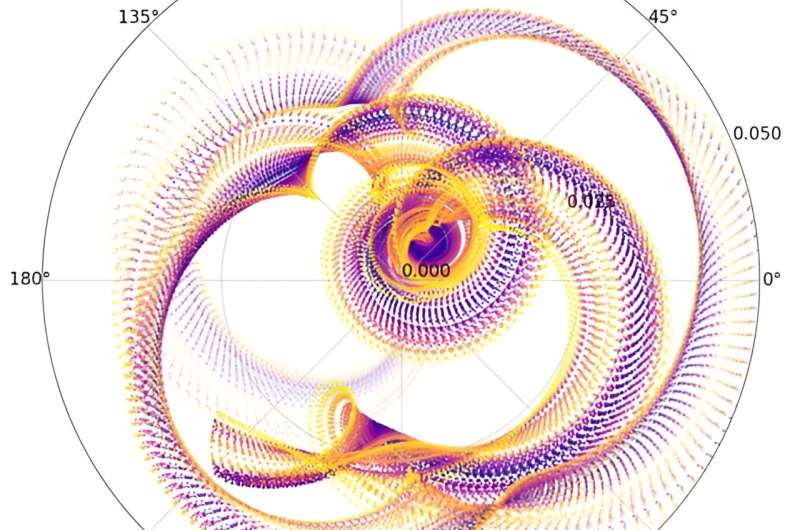This article has been reviewed according to Science X's editorial process and policies. Editors have highlighted the following attributes while ensuring the content's credibility:
fact-checked
trusted source
proofread
Passing stars altered orbital evolution of Earth and other planets, astronomers find

Stars that pass by our solar system have altered the long-term orbital evolution of planets, including Earth, and, by extension, modified our climate.
"Perturbations—a minor deviation in the course of a celestial body, caused by the gravitational attraction of a neighboring body—from passing stars alter the long-term orbital evolution of the sun's planets, including Earth," said Nathan A. Kaib, Senior Scientist at the Planetary Science Institute and lead author of "Passing Stars as an Important Driver of Paleoclimate and the solar system's Orbital Evolution" that appears in The Astrophysical Journal Letters. Sean Raymond at the Laboratoire d'Astrophysique de Bordeaux also contributed to this work.
"One reason this is important is because the geologic record shows that changes in the Earth's orbital eccentricity accompany fluctuations in the Earth's climate. If we want to best search for the causes of ancient climate anomalies, it is important to have an idea of what Earth's orbit looked like during those episodes," Kaib said.
"One example of such an episode is the Paleocene-Eocene Thermal Maximum 56 million years ago, where the Earth's temperature rose 5-8 degrees centigrade. It has already been proposed that Earth's orbital eccentricity was notably high during this event, but our results show that passing stars make detailed predictions of Earth's past orbital evolution at this time highly uncertain, and a broader spectrum of orbital behavior is possible than previously thought."
Simulations (run backward) are used to predict the past orbital evolution of the Earth and the sun's other planets. Analogous to weather forecasting, this technique gets less accurate as you extend it to longer times because of the exponential growth of uncertainties. Previously, the effects of stars passing near the sun were not considered in these "backward forecasts."
As the sun and other stars orbit the center of the Milky Way, they inevitably can pass near one another, sometimes within tens of thousands of au, 1 au being the distance from the Earth to the sun. These events are called stellar encounters. For instance, a star passes within 50,000 au of the sun every 1 million years on average, and a star passes within 10,000 au of the sun every 20 million years on average. This study's simulations include these types of events, whereas most prior similar simulations do not.
One major reason the Earth's orbital eccentricity fluctuates over time is because it receives regular perturbations from the giant planets of our solar system (Jupiter, Saturn, Uranus, and Neptune). As stars pass near our solar system, they perturb the giant planet's orbits, which consequently then alters the orbital trajectory of the Earth. Thus, the giant planets serve as a link between the Earth and passing stars.
Kaib said that when simulations include stellar passages, we find that orbital uncertainties grow even faster, and the time horizon beyond which these backward simulations' predictions become unreliable is more recent than thought.
This means two things: There are past epochs in Earth's history where our confidence in what Earth's orbit looked like (for example, its eccentricity or degree of circularity) has been too high, and the real orbital state is not known, and the effects of passing stars make regimes of orbital evolution (extended periods of particularly high or low eccentricity) possible that past models did not predict.
"Given these results, we have also identified one known recent stellar passage, the sun-like star HD 7977, which occurred 2.8 million years ago, that is potentially powerful enough to alter simulations' predictions of what Earth's orbit was like beyond approximately 50 million years ago," Kaib said.
The current observational uncertainty of HD 7977's closest encounter distance is large, however, ranging from 4,000 au to 31,000 au. "For larger encounter distances, HD 7977 would not have a significant impact on Earth's encounter distance. Near the smaller end of the range, however, it would likely alter our predictions of Earth's past orbit," Kaib said.
More information: Nathan A. Kaib et al, Passing Stars as an Important Driver of Paleoclimate and the Solar System's Orbital Evolution, The Astrophysical Journal Letters, (2024). DOI: 10.3847/2041-8213/ad24fb. iopscience.iop.org/article/10. … 847/2041-8213/ad24fb
Provided by Planetary Science Institute





















